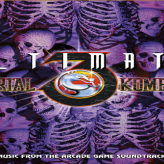- Retro Games
- Ultimate Mortal Kombat 3 (Arcade)
Advertisement
Advertisement
Advertisement
Advertisement
Advertisement
Advertisement

Ultimate Mortal Kombat 3 (Arcade)
In 1995, Midway created and released Ultimate Mortal Kombat 3, a fighting game in the Mortal Kombat series, for arcades. It is an independent update to...
Ultimate Mortal Kombat 3: Unleash the Brutal Fury
The Battle Begins
"GET OVER HERE!" - these iconic words have echoed through the ages of gaming, and they mark the return of one of the most legendary titles in the arcade gaming universe. Ultimate Mortal Kombat 3, or UMK3, is not just a game; it's an experience that has left an indelible mark on the world of fighting games. Developed and released by Midway in 1995, UMK3 is a standout in the Mortal Kombat series, and it's time to step into the ring, get ready for the fight, and explore what makes this game a classic.
The Ultimate Fighting Experience
UMK3 is a standalone update to its predecessor, Mortal Kombat 3, but it brings a whirlwind of new features and characters to the arena. The game introduces an altered gameplay system, resurrecting fan-favorites like Kitana and Scorpion, who were notably absent in Mortal Kombat 3. These additions inject new life into the Mortal Kombat universe, offering fresh strategies and combat styles for players to master.
After its arcade debut, UMK3 made its way to various home consoles. While no version perfectly replicated the arcade experience, the Sega Saturn port came remarkably close. Other iterations followed, each striving for authenticity. Some versions were released under different titles, such as "Mortal Kombat Advance" for the Game Boy Advance in 2001 and "Ultimate Mortal Kombat" for the Nintendo DS in 2007. Even iOS users got a taste of the action when Electronic Arts released a 3D graphics engine version in 2010.
UMK3 was met with widespread acclaim, solidifying its status as a high point in the Mortal Kombat franchise. However, not all adaptations fared equally well. The iOS remake and certain other home versions received mixed reviews. Yet, the game's legacy endures, with UMK3 later being expanded into "Mortal Kombat Trilogy" in 1996. To this day, players can revisit the classic in the 2011 compilation "Mortal Kombat Arcade Kollection," which includes an emulation of UMK3 alongside the first two Mortal Kombat titles.
Unleashing the Brutal Fury
Gameplay
UMK3 introduces two new gameplay modes that set it apart from its predecessor. First, the 2-on-2 mode allows for battles reminiscent of Endurance matches but with up to three human players on each side. This mode revives a classic format not seen since the original Mortal Kombat, bringing new layers of strategy and excitement. Additionally, a thrilling eight-player Tournament mode pushes players to their limits in a fierce competition for dominance.
To maintain balance, the game bestows new moves upon certain characters while altering existing ones. Players discover extra combos and adjusted combo damage, ensuring a fairer and more dynamic fighting experience. The introduction of chain combos, triggered by jump punches or vertical jump kicks, expands the possibilities for devastating attack combinations. Furthermore, multi-layered levels no longer send opponents to the level above when hit by aerial attacks; this privilege is now reserved for regular uppercuts.
AI opponents receive significant improvements in UMK3. However, these enhancements come with their own quirks. For example, when a player performs a jump kick while backflipping away from an opponent, the AI character consistently responds with a projectile attack, leaving them vulnerable to counterattacks. Similarly, if a player repeatedly moves back and forth within a specific range of the AI character, the opponent mimics this movement throughout the round, rarely launching attacks. In addition, when cornered, AI opponents can be easily overwhelmed by repeated punches.
UMK3 boasts several new backgrounds, each with its unique flair. Notable stages include Scorpion's Lair/Hell, featuring a Stage Fatality involving a river of lava, and Jade's Desert, where Cyrax is humorously trapped in sand, a nod to his MK3 ending. The game's backgrounds enhance the overall visual experience and add depth to the battles.
Some elements from MK3 are notably absent in UMK3. For instance, the biographies and full-body portraits of MK3 characters are missing, as are the accompanying storyline images and text. Additionally, stages like the Bank and Hidden Portal, present in MK3, were removed. However, UMK3 includes new stages like Noob's Dorfen, adding variety to the game's environments.
The Legendary Controls
Controlling the mayhem in UMK3 is a crucial aspect of mastering the game. Here are the basic controls:
- Arrow Keys: Use directional buttons for movement.
- "Z" Key: The A button.
- "X" Key: The B button.
- Space: Select.
- Enter: Start.
Players can save their progress by hovering over the emulator screen and utilizing the icons for saving and loading. The down arrow icon signifies saving, while the up arrow icon represents loading.
In Conclusion - The Brutality Lives On
In conclusion, Ultimate Mortal Kombat 3 stands as a testament to the enduring legacy of the Mortal Kombat franchise. Its blend of nostalgia and fresh gameplay mechanics has solidified its place in gaming history. Whether you're a seasoned player reliving the past or a newcomer experiencing it for the first time, UMK3 promises hours of brutal and exhilarating combat.
As you step into the arena, remember the words that have become synonymous with the franchise: "GET OVER HERE!" It's time to unleash your inner warrior, master the fatalities, and prove your mettle in one of gaming's most iconic and brutal fighting games.
So, are you ready to embrace the fury of Ultimate Mortal Kombat 3? The battle awaits, and only the strongest will emerge victorious.
Instructions
Using Mouse































Discuss: Ultimate Mortal Kombat 3 (Arcade)